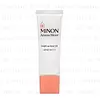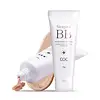What's inside
What's inside
 Key Ingredients
Key Ingredients

 Benefits
Benefits

 Concerns
Concerns

 Ingredients Side-by-side
Ingredients Side-by-side

Water
Skin ConditioningCyclopentasiloxane
EmollientTitanium Dioxide
Cosmetic ColorantDiphenylsiloxy Phenyl Trimethicone
Skin ConditioningPEG-9 Polydimethylsiloxyethyl Dimethicone
EmulsifyingOctyldodecyl Myristate
EmollientTriethylhexanoin
MaskingPentylene Glycol
Skin ConditioningButylene Glycol
HumectantCetyl PEG/PPG-10/1 Dimethicone
EmulsifyingDisteardimonium Hectorite
StabilisingTrimethylsiloxysilicate
EmollientLauroyl Lysine
Skin ConditioningVinyl Dimethicone/Methicone Silsesquioxane Crosspolymer
Zinc Chloride
AntimicrobialPotassium Hydroxide
BufferingStearic Acid
CleansingDipentaerythrityl Tri-Polyhydroxystearate
EmollientPhytosteryl/Octyldodecyl Lauroyl Glutamate
Skin ConditioningTribehenin
EmollientPhenoxyethanol
PreservativeVinyl Dimethicone/Lauryl Dimethicone Crosspolymer
Tocopherol
AntioxidantStearyl Glycyrrhetinate
Skin ConditioningMethicone
EmollientBifida Polysaccharide
HumectantPPG-12
Skin ConditioningSilica
AbrasiveLimnanthes Alba Seed Oil
Skin ConditioningCarnosine
Skin ConditioningTaurine
BufferingGlycerin
HumectantLysine Hcl
Skin ConditioningPolyquaternium-61
Skin ConditioningGlutamic Acid
HumectantGlycine
BufferingLeucine
Skin ConditioningHistidine Hcl
Skin ConditioningSerine
MaskingValine
MaskingTin Oxide
AbrasiveZinc Aspartate
Skin ConditioningThreonine
Alanine
MaskingIsoleucine
Skin ConditioningAllantoin
Skin ConditioningPhenylalanine
MaskingArginine
MaskingProline
Skin ConditioningTyrosine
MaskingAlginic Acid
Skin ConditioningDisodium Guanylate
EmollientTalc
AbrasiveDimethicone
EmollientBoron Nitride
AbsorbentCI 77492
Cosmetic ColorantWater, Cyclopentasiloxane, Titanium Dioxide, Diphenylsiloxy Phenyl Trimethicone, PEG-9 Polydimethylsiloxyethyl Dimethicone, Octyldodecyl Myristate, Triethylhexanoin, Pentylene Glycol, Butylene Glycol, Cetyl PEG/PPG-10/1 Dimethicone, Disteardimonium Hectorite, Trimethylsiloxysilicate, Lauroyl Lysine, Vinyl Dimethicone/Methicone Silsesquioxane Crosspolymer, Zinc Chloride, Potassium Hydroxide, Stearic Acid, Dipentaerythrityl Tri-Polyhydroxystearate, Phytosteryl/Octyldodecyl Lauroyl Glutamate, Tribehenin, Phenoxyethanol, Vinyl Dimethicone/Lauryl Dimethicone Crosspolymer, Tocopherol, Stearyl Glycyrrhetinate, Methicone, Bifida Polysaccharide, PPG-12, Silica, Limnanthes Alba Seed Oil, Carnosine, Taurine, Glycerin, Lysine Hcl, Polyquaternium-61, Glutamic Acid, Glycine, Leucine, Histidine Hcl, Serine, Valine, Tin Oxide, Zinc Aspartate, Threonine, Alanine, Isoleucine, Allantoin, Phenylalanine, Arginine, Proline, Tyrosine, Alginic Acid, Disodium Guanylate, Talc, Dimethicone, Boron Nitride, CI 77492
Water
Skin ConditioningTitanium Dioxide
Cosmetic ColorantCyclopentasiloxane
EmollientCyclohexasiloxane
EmollientGlycerin
HumectantMethyl Methacrylate Crosspolymer
Dimethicone
EmollientButylene Glycol
HumectantDimethicone/Vinyl Dimethicone Crosspolymer
Skin ConditioningPhenyl Trimethicone
Skin ConditioningNiacinamide
SmoothingPolyglyceryl-3 Polydimethylsiloxyethyl Dimethicone
Skin ConditioningButylene Glycol Dicaprylate/Dicaprate
EmollientSodium Chloride
MaskingTrehalose
HumectantDisteardimonium Hectorite
StabilisingSorbitan Sesquioleate
EmulsifyingTocopheryl Acetate
AntioxidantSimmondsia Chinensis Seed Oil
EmollientMacadamia Ternifolia Seed Oil
EmollientScutellaria Baicalensis Extract
AntimicrobialIllicium Verum Fruit Extract
PerfumingTocopherol
AntioxidantCI 77492
Cosmetic ColorantCI 77491
Cosmetic ColorantCI 77499
Cosmetic ColorantTriethoxycaprylylsilane
1,2-Hexanediol
Skin ConditioningAllantoin
Skin ConditioningBetaine
HumectantAdenosine
Skin ConditioningDisodium EDTA
Acetyl Hexapeptide-8
HumectantSh-Oligopeptide-1
Skin ConditioningSodium Hyaluronate
HumectantCentella Asiatica Extract
CleansingWater, Titanium Dioxide, Cyclopentasiloxane, Cyclohexasiloxane, Glycerin, Methyl Methacrylate Crosspolymer, Dimethicone, Butylene Glycol, Dimethicone/Vinyl Dimethicone Crosspolymer, Phenyl Trimethicone, Niacinamide, Polyglyceryl-3 Polydimethylsiloxyethyl Dimethicone, Butylene Glycol Dicaprylate/Dicaprate, Sodium Chloride, Trehalose, Disteardimonium Hectorite, Sorbitan Sesquioleate, Tocopheryl Acetate, Simmondsia Chinensis Seed Oil, Macadamia Ternifolia Seed Oil, Scutellaria Baicalensis Extract, Illicium Verum Fruit Extract, Tocopherol, CI 77492, CI 77491, CI 77499, Triethoxycaprylylsilane, 1,2-Hexanediol, Allantoin, Betaine, Adenosine, Disodium EDTA, Acetyl Hexapeptide-8, Sh-Oligopeptide-1, Sodium Hyaluronate, Centella Asiatica Extract
Ingredients Explained
These ingredients are found in both products.
Ingredients higher up in an ingredient list are typically present in a larger amount.
Allantoin is a soothing ingredient known for its protective and moisturizingg properties. Because of this, it is often added to products with strong active ingredients.
Studies show higher concentrations of this ingredient can promote wound healing.
Though it can be derived from the comfrey plant, allantoin is produced synthetically for cosmetic products to ensure purity.
Learn more about AllantoinButylene Glycol (or BG) is used within cosmetic products for a few different reasons:
Overall, Butylene Glycol is a safe and well-rounded ingredient that works well with other ingredients.
Though this ingredient works well with most skin types, some people with sensitive skin may experience a reaction such as allergic rashes, closed comedones, or itchiness.
Learn more about Butylene GlycolCi 77492 is also hydrated iron III oxide. It's sole purpose is to give a yellow hue to products.
Iron III oxides are classified as inorganic chemicals for coloring.
Synthetically created Ci 77492 is considered safer than those naturally found. This is because the synthetically created version may contain less impurities. Iron oxides are generally non-toxic and non-allergenic.
Learn more about CI 77492Cyclopentasiloxane, or D5, is a silicone used to improve texture of products and trap moisture.
D5 is considered lightweight and volatile. Volatile means it evaporates quickly after application. Once evaporated, D5 leaves a thin barrier that helps keep skin hydrated.
It is also an emollient. Emollients help soften the skin and prevent water loss. Silicones create a silky texture in products. D5 helps other ingredients become more spreadable.
Studies show D5 is safe to use in skincare products. We recommend speaking with a skincare professional if you have concerns.
Learn more about CyclopentasiloxaneDimethicone is a type of synthetic silicone created from natural materials such as quartz.
What it does:
Dimethicone comes in different viscosities:
Depending on the viscosity, dimethicone has different properties.
Ingredients lists don't always show which type is used, so we recommend reaching out to the brand if you have questions about the viscosity.
This ingredient is unlikely to cause irritation because it does not get absorbed into skin. However, people with silicone allergies should be careful about using this ingredient.
Note: Dimethicone may contribute to pilling. This is because it is not oil or water soluble, so pilling may occur when layered with products. When mixed with heavy oils in a formula, the outcome is also quite greasy.
Learn more about DimethiconeDisteardimonium Hectorite comes from the clay mineral named hectorite. It is used to add thickness to a product.
It can also help stabilize a product by helping to disperse other ingredients.
Hectorite is a rare, white clay mineral.
Learn more about Disteardimonium HectoriteGlycerin is already naturally found in your skin. It helps moisturize and protect your skin.
A study from 2016 found glycerin to be more effective as a humectant than AHAs and hyaluronic acid.
As a humectant, it helps the skin stay hydrated by pulling moisture to your skin. The low molecular weight of glycerin allows it to pull moisture into the deeper layers of your skin.
Hydrated skin improves your skin barrier; Your skin barrier helps protect against irritants and bacteria.
Glycerin has also been found to have antimicrobial and antiviral properties. Due to these properties, glycerin is often used in wound and burn treatments.
In cosmetics, glycerin is usually derived from plants such as soybean or palm. However, it can also be sourced from animals, such as tallow or animal fat.
This ingredient is organic, colorless, odorless, and non-toxic.
Glycerin is the name for this ingredient in American English. British English uses Glycerol/Glycerine.
Learn more about GlycerinTitanium dioxide is a mineral UV filter widely used in sunscreens and cosmetics.
It is one of only two UV filters officially classified as “mineral” by regulatory agencies, the other being zinc oxide.
Titanium dioxide provides broad-spectrum protection mostly in the UVB and UVAII range, with some protection in the UVAI range.
While its UVA protection isn’t as strong as zinc oxide’s, the difference is minor.
A common myth is that mineral UV filters reflect UV light. However, modern research shows titanium dioxide absorbs UV radiation like chemical filters (~95% absorption & 5% reflection).
Thanks to its non-irritating nature, titanium dioxide is suitable for sensitive, acne-prone, or redness-prone skin. It is unlikely to cause "eye sting" like other sunscreen ingredients.
A major drawback of this ingredient is its white cast and thick texture. This is why mineral sunscreens often leave a white cast and are less cosmetically elegant than chemical/hybrid sunscreens.
To improve white cast and spreadability, micronized or nano-sized titanium dioxide is often used.
There are ongoing concerns surrounding nano-titanium oxide's impact on marine ecosystems.
There is no conclusive evidence that any form of titanium oxide (or any other sunscreen ingredients) will cause harm to marine ecosystems or coral reefs. The science is still developing but many consumers are keeping a close eye on this issue.
Please note, many destinations have reef-safety sunscreen rules. For instance, the U.S. Virgin Islands advises all visitors to use non-nano mineral sunscreens.
Nano mineral sunscreens once raised safety concerns about absorption into skin.
Extensive research has shown that they do not penetrate healthy or damaged skin; they remain safely on the surface and the top layer of dead skin (stratum corneum).
You'll likely find titanium dioxide bundled with alumina, silica, or dimethicone. These ingredients help make titanium dioxide highly photostable; this prevents it from interacting with other formula components under UV light.
Learn more about Titanium DioxideTocopherol (also known as Vitamin E) is a common antioxidant used to help protect the skin from free-radicals and strengthen the skin barrier. It's also fat soluble - this means our skin is great at absorbing it.
Vitamin E also helps keep your natural skin lipids healthy. Your lipid skin barrier naturally consists of lipids, ceramides, and fatty acids. Vitamin E offers extra protection for your skin’s lipid barrier, keeping your skin healthy and nourished.
Another benefit is a bit of UV protection. Vitamin E helps reduce the damage caused by UVB rays. (It should not replace your sunscreen). Combining it with Vitamin C can decrease sunburned cells and hyperpigmentation after UV exposure.
You might have noticed Vitamin E + C often paired together. This is because it is great at stabilizing Vitamin C. Using the two together helps increase the effectiveness of both ingredients.
There are often claims that Vitamin E can reduce/prevent scarring, but these claims haven't been confirmed by scientific research.
Learn more about TocopherolWater. It's the most common cosmetic ingredient of all. You'll usually see it at the top of ingredient lists, meaning that it makes up the largest part of the product.
So why is it so popular? Water most often acts as a solvent - this means that it helps dissolve other ingredients into the formulation.
You'll also recognize water as that liquid we all need to stay alive. If you see this, drink a glass of water. Stay hydrated!
Learn more about Water